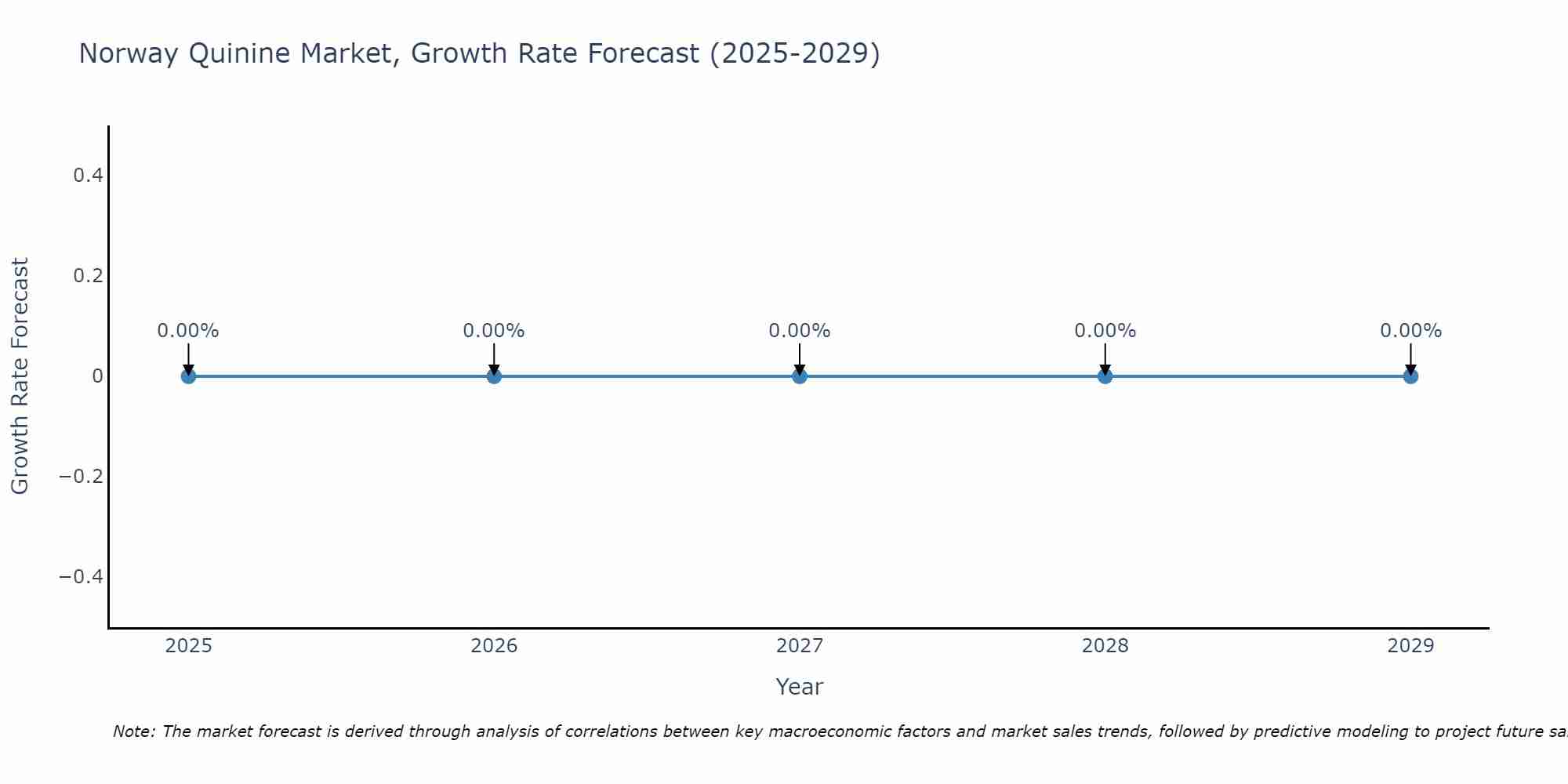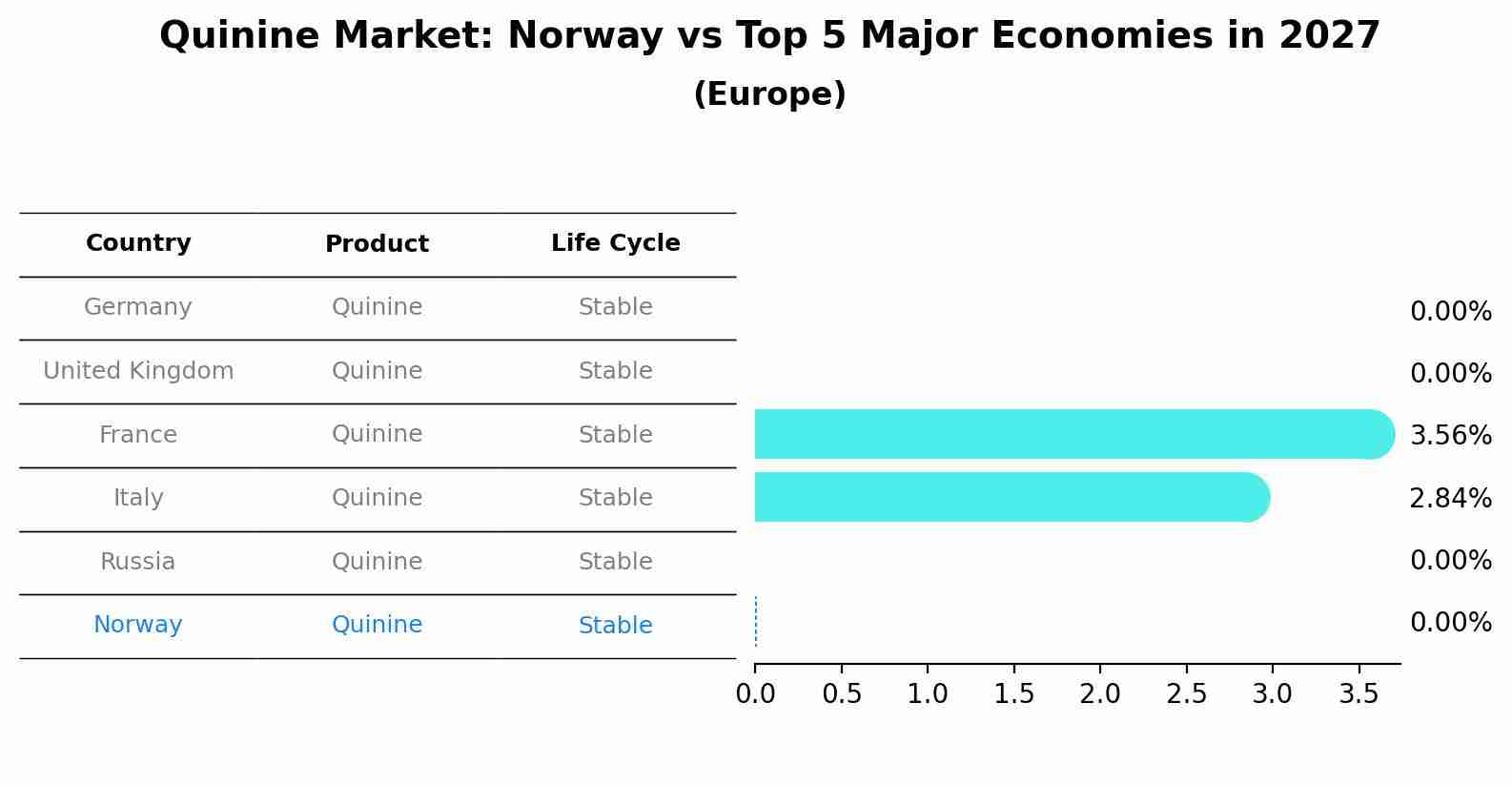Norway Quinine Market (2025-2031) | Industry, Growth, Companies, Segmentation, Value, Trends, Size, Share, Forecast, Outlook, Revenue & Analysis
| Product Code: ETC5312501 | Publication Date: Nov 2023 | Updated Date: Aug 2025 | Product Type: Market Research Report | |
| Publisher: 6Wresearch | Author: Bhawna Singh | No. of Pages: 60 | No. of Figures: 30 | No. of Tables: 5 |
Norway Quinine Market Size Growth Rate
The Norway Quinine Market is expected to maintain a stable growth rate from 2025 to 2029. Beginning strongly at 0.00% in 2025, growth softens to 0.00% in 2029.

Quinine Market: Norway vs Top 5 Major Economies in 2027 (Europe)
By 2027, the Quinine market in Norway is anticipated to reach a growth rate of 0.00%, as part of an increasingly competitive Europe region, where Germany remains at the forefront, supported by United Kingdom, France, Italy and Russia, driving innovations and market adoption across sectors.

Norway Quinine Market Overview
Norways Quinine market, primarily used in the pharmaceutical industry for treating malaria and in beverages like tonic water, remains niche but stable. The demand for quinine in the country is influenced by its use in pharmaceuticals, though the market faces challenges from synthetic alternatives and changing treatment guidelines. However, the beverage industry, particularly the premium tonic water segment, continues to sustain demand for quinine as a natural ingredient.
Drivers of the market
The quinine market in Norway is primarily driven by its demand in the pharmaceutical industry, particularly for the treatment of malaria and leg cramps. Although Norway has a low incidence of malaria, the quinine market is supported by its export to other regions and its use in pharmaceuticals. Additionally, quinines use as a flavoring agent in beverages, such as tonic water, also contributes to the market demand.
Challenges of the market
The quinine market in Norway is impacted by regulatory constraints and fluctuations in global supply. Quinine, used primarily for its medicinal properties in treating malaria, is subject to strict regulations regarding its production and distribution. Changes in international trade policies, as well as challenges in sourcing high-quality raw materials, can affect market stability. Additionally, the market faces competition from alternative treatments and therapies, which can influence demand for quinine-based products.
Government Policy of the market
The quinine market in Norway is regulated by healthcare and pharmaceutical policies that ensure the safety and efficacy of medicinal products. The Norwegian Medicines Agency oversees the approval and regulation of quinine used for treating malaria and other conditions. Government policies focus on maintaining high standards for drug safety and efficacy, including stringent testing and approval processes. Additionally, Norways healthcare policies support research and development in pharmaceuticals, influencing the quinine market by fostering innovation and ensuring access to effective treatments.
Key Highlights of the Report:
- Norway Quinine Market Outlook
- Market Size of Norway Quinine Market, 2024
- Forecast of Norway Quinine Market, 2031
- Historical Data and Forecast of Norway Quinine Revenues & Volume for the Period 2021-2031
- Norway Quinine Market Trend Evolution
- Norway Quinine Market Drivers and Challenges
- Norway Quinine Price Trends
- Norway Quinine Porter`s Five Forces
- Norway Quinine Industry Life Cycle
- Historical Data and Forecast of Norway Quinine Market Revenues & Volume By Mode of Administration for the Period 2021-2031
- Historical Data and Forecast of Norway Quinine Market Revenues & Volume By Oral Administration for the Period 2021-2031
- Historical Data and Forecast of Norway Quinine Market Revenues & Volume By Intravenous Administration for the Period 2021-2031
- Historical Data and Forecast of Norway Quinine Market Revenues & Volume By Intramuscular Administration for the Period 2021-2031
- Historical Data and Forecast of Norway Quinine Market Revenues & Volume By Others for the Period 2021-2031
- Historical Data and Forecast of Norway Quinine Market Revenues & Volume By Application for the Period 2021-2031
- Historical Data and Forecast of Norway Quinine Market Revenues & Volume By Antimalarial for the Period 2021-2031
- Historical Data and Forecast of Norway Quinine Market Revenues & Volume By Antipyretic for the Period 2021-2031
- Historical Data and Forecast of Norway Quinine Market Revenues & Volume By Others for the Period 2021-2031
- Historical Data and Forecast of Norway Quinine Market Revenues & Volume By End-user for the Period 2021-2031
- Historical Data and Forecast of Norway Quinine Market Revenues & Volume By Hospitals for the Period 2021-2031
- Historical Data and Forecast of Norway Quinine Market Revenues & Volume By Clinics for the Period 2021-2031
- Historical Data and Forecast of Norway Quinine Market Revenues & Volume By Ambulatory Surgical Centers for the Period 2021-2031
- Historical Data and Forecast of Norway Quinine Market Revenues & Volume By Others for the Period 2021-2031
- Norway Quinine Import Export Trade Statistics
- Market Opportunity Assessment By Mode of Administration
- Market Opportunity Assessment By Application
- Market Opportunity Assessment By End-user
- Norway Quinine Top Companies Market Share
- Norway Quinine Competitive Benchmarking By Technical and Operational Parameters
- Norway Quinine Company Profiles
- Norway Quinine Key Strategic Recommendations
Frequently Asked Questions About the Market Study (FAQs):
1 Executive Summary |
2 Introduction |
2.1 Key Highlights of the Report |
2.2 Report Description |
2.3 Market Scope & Segmentation |
2.4 Research Methodology |
2.5 Assumptions |
3 Norway Quinine Market Overview |
3.1 Norway Country Macro Economic Indicators |
3.2 Norway Quinine Market Revenues & Volume, 2021 & 2031F |
3.3 Norway Quinine Market - Industry Life Cycle |
3.4 Norway Quinine Market - Porter's Five Forces |
3.5 Norway Quinine Market Revenues & Volume Share, By Mode of Administration, 2021 & 2031F |
3.6 Norway Quinine Market Revenues & Volume Share, By Application, 2021 & 2031F |
3.7 Norway Quinine Market Revenues & Volume Share, By End-user, 2021 & 2031F |
4 Norway Quinine Market Dynamics |
4.1 Impact Analysis |
4.2 Market Drivers |
4.2.1 Increasing awareness about the health benefits of quinine consumption in Norway |
4.2.2 Growing demand for natural and herbal remedies in the Norwegian market |
4.2.3 Rising prevalence of lifestyle-related health conditions driving the need for quinine products |
4.3 Market Restraints |
4.3.1 Stringent regulations and quality standards governing the production and sale of quinine in Norway |
4.3.2 Competition from alternative natural remedies and supplements in the market |
5 Norway Quinine Market Trends |
6 Norway Quinine Market Segmentations |
6.1 Norway Quinine Market, By Mode of Administration |
6.1.1 Overview and Analysis |
6.1.2 Norway Quinine Market Revenues & Volume, By Oral Administration, 2021-2031F |
6.1.3 Norway Quinine Market Revenues & Volume, By Intravenous Administration, 2021-2031F |
6.1.4 Norway Quinine Market Revenues & Volume, By Intramuscular Administration, 2021-2031F |
6.1.5 Norway Quinine Market Revenues & Volume, By Others, 2021-2031F |
6.2 Norway Quinine Market, By Application |
6.2.1 Overview and Analysis |
6.2.2 Norway Quinine Market Revenues & Volume, By Antimalarial, 2021-2031F |
6.2.3 Norway Quinine Market Revenues & Volume, By Antipyretic, 2021-2031F |
6.2.4 Norway Quinine Market Revenues & Volume, By Others, 2021-2031F |
6.3 Norway Quinine Market, By End-user |
6.3.1 Overview and Analysis |
6.3.2 Norway Quinine Market Revenues & Volume, By Hospitals, 2021-2031F |
6.3.3 Norway Quinine Market Revenues & Volume, By Clinics, 2021-2031F |
6.3.4 Norway Quinine Market Revenues & Volume, By Ambulatory Surgical Centers, 2021-2031F |
6.3.5 Norway Quinine Market Revenues & Volume, By Others, 2021-2031F |
7 Norway Quinine Market Import-Export Trade Statistics |
7.1 Norway Quinine Market Export to Major Countries |
7.2 Norway Quinine Market Imports from Major Countries |
8 Norway Quinine Market Key Performance Indicators |
8.1 Consumer awareness levels of quinine and its benefits in Norway |
8.2 Number of new product launches and innovations in the quinine market in Norway |
8.3 Adoption rate of quinine products by health-conscious consumers in Norway |
9 Norway Quinine Market - Opportunity Assessment |
9.1 Norway Quinine Market Opportunity Assessment, By Mode of Administration, 2021 & 2031F |
9.2 Norway Quinine Market Opportunity Assessment, By Application, 2021 & 2031F |
9.3 Norway Quinine Market Opportunity Assessment, By End-user, 2021 & 2031F |
10 Norway Quinine Market - Competitive Landscape |
10.1 Norway Quinine Market Revenue Share, By Companies, 2024 |
10.2 Norway Quinine Market Competitive Benchmarking, By Operating and Technical Parameters |
11 Company Profiles |
12 Recommendations | 13 Disclaimer |
- Single User License$ 1,995
- Department License$ 2,400
- Site License$ 3,120
- Global License$ 3,795
Search
Thought Leadership and Analyst Meet
Our Clients
Related Reports
- Canada Oil and Gas Market (2026-2032) | Share, Segmentation, Value, Industry, Trends, Forecast, Analysis, Size & Revenue, Growth, Competitive Landscape, Outlook, Companies
- Germany Breakfast Food Market (2026-2032) | Industry, Share, Growth, Size, Companies, Value, Analysis, Revenue, Trends, Forecast & Outlook
- Australia Briquette Market (2025-2031) | Growth, Size, Revenue, Forecast, Analysis, Trends, Value, Share, Industry & Companies
- Vietnam System Integrator Market (2025-2031) | Size, Companies, Analysis, Industry, Value, Forecast, Growth, Trends, Revenue & Share
- ASEAN and Thailand Brain Health Supplements Market (2025-2031) | Strategy, Consumer Insights, Analysis, Investment Trends, Opportunities, Growth, Size, Share, Industry, Revenue, Segments, Value, Segmentation, Supply, Forecast, Restraints, Outlook, Competition, Drivers, Trends, Demand, Pricing Analysis, Competitive, Strategic Insights, Companies, Challenges
- ASEAN Bearings Market (2025-2031) | Strategy, Consumer Insights, Analysis, Investment Trends, Opportunities, Growth, Size, Share, Industry, Revenue, Segments, Value, Segmentation, Supply, Forecast, Restraints, Outlook, Competition, Drivers, Trends, Demand, Pricing Analysis, Competitive, Strategic Insights, Companies, Challenges
- Europe Flooring Market (2025-2031) | Outlook, Share, Industry, Trends, Forecast, Companies, Revenue, Size, Analysis, Growth & Value
- Saudi Arabia Manlift Market (2025-2031) | Outlook, Size, Growth, Trends, Companies, Industry, Revenue, Value, Share, Forecast & Analysis
- Uganda Excavator, Crane, and Wheel Loaders Market (2025-2031) | Strategy, Consumer Insights, Analysis, Investment Trends, Opportunities, Growth, Size, Share, Industry, Revenue, Segments, Value, Segmentation, Supply, Forecast, Restraints, Outlook, Competition, Drivers, Trends, Demand, Pricing Analysis, Competitive, Strategic Insights, Companies, Challenges
- Rwanda Excavator, Crane, and Wheel Loaders Market (2025-2031) | Strategy, Consumer Insights, Analysis, Investment Trends, Opportunities, Growth, Size, Share, Industry, Revenue, Segments, Value, Segmentation, Supply, Forecast, Restraints, Outlook, Competition, Drivers, Trends, Demand, Pricing Analysis, Competitive, Strategic Insights, Companies, Challenges
Industry Events and Analyst Meet
Whitepaper
- Middle East & Africa Commercial Security Market Click here to view more.
- Middle East & Africa Fire Safety Systems & Equipment Market Click here to view more.
- GCC Drone Market Click here to view more.
- Middle East Lighting Fixture Market Click here to view more.
- GCC Physical & Perimeter Security Market Click here to view more.
6WResearch In News
- Doha a strategic location for EV manufacturing hub: IPA Qatar
- Demand for luxury TVs surging in the GCC, says Samsung
- Empowering Growth: The Thriving Journey of Bangladesh’s Cable Industry
- Demand for luxury TVs surging in the GCC, says Samsung
- Video call with a traditional healer? Once unthinkable, it’s now common in South Africa
- Intelligent Buildings To Smooth GCC’s Path To Net Zero


















